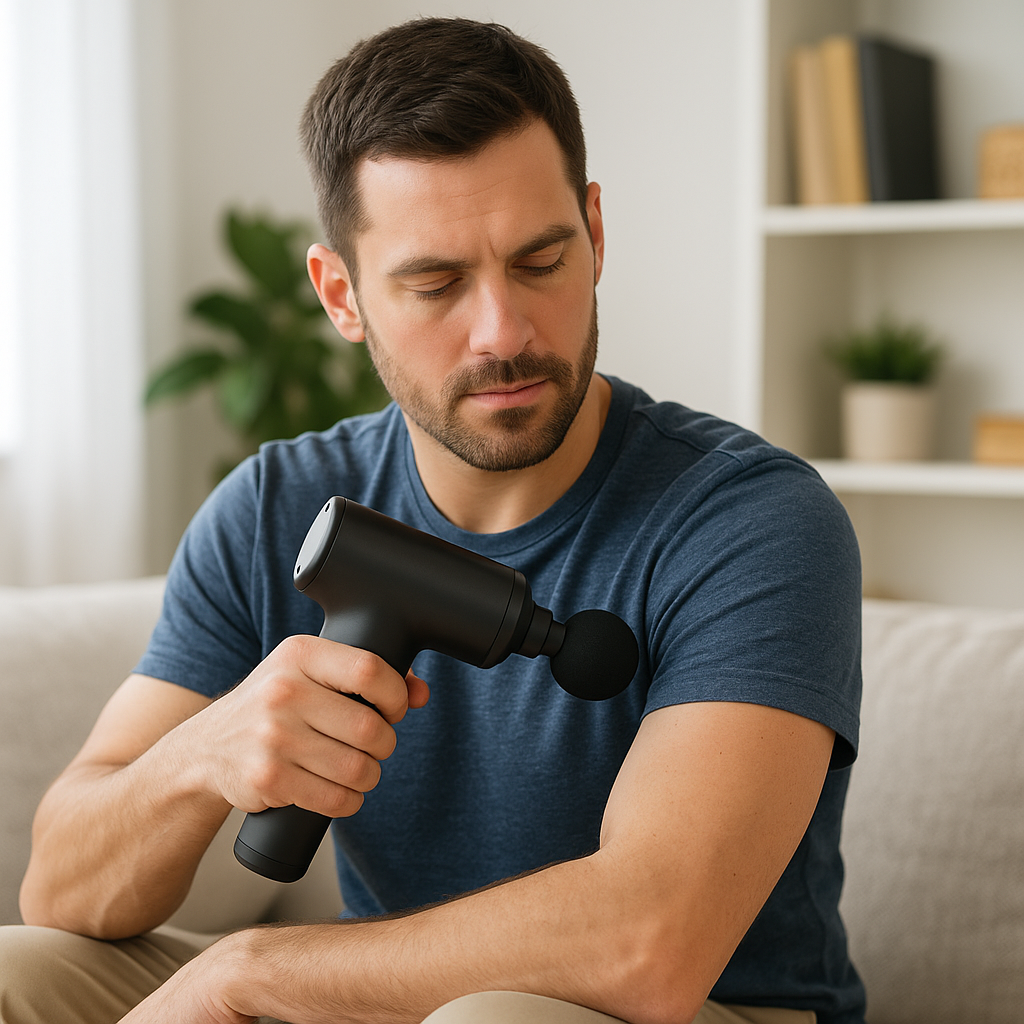Massage guns are powerful tools for relieving tension, improving circulation, and speeding up recovery but using them correctly is key to getting the best results. Many people make the mistake of applying too much pressure or spending too long on one spot, which can actually cause irritation instead of relief.
So, how long should you use a massage gun on one area to relax your muscles safely and effectively? In this article, we’ll explain the ideal duration, best techniques, and safety tips to help you get the most from your massage gun without overdoing it.
What is the ideal duration for using a massage gun on one area?
Massage guns are designed to provide targeted, deep-tissue relief by delivering rapid pulses of pressure to your muscles. However, using them effectively depends on more than just intensity timing plays a crucial role. Applying a massage gun for too long can overstimulate the muscles or even cause soreness, while too short a session may not deliver the desired benefits.
So, what’s the right amount of time to use a massage gun on a single area? Let’s break it down by purpose, muscle type, and activity level to help you get optimal results safely.
General rule: 30 seconds to 2 minutes per area
In most cases, the ideal duration for using a massage gun on one muscle group is between 30 seconds and 2 minutes. This timeframe allows enough time to stimulate circulation, release tension, and activate or relax the muscle without causing irritation or fatigue.
Shorter sessions (around 30–60 seconds) are best for pre-workout warm-ups, while longer ones (up to 2 minutes) are more effective for post-workout recovery or tension relief. Spending more than two minutes on the same area can lead to overstimulation or bruising, especially on sensitive muscles.
Pre-workout use: 30 to 60 seconds
Before exercising, the goal of using a massage gun is to wake up the muscles and prepare them for movement. A short session of 30–60 seconds per muscle group helps increase blood flow, enhance mobility, and warm up the tissue.
Focus on major muscle groups you plan to use during your workout — for example:
-
Quads, calves, and hamstrings before a run.
-
Shoulders, triceps, and chest before upper-body training.
-
Lower back and hips before full-body workouts.
Use a low to medium speed setting and keep the gun moving slowly across the muscle surface. Avoid pressing too hard light pressure is enough to stimulate circulation and prevent muscle stiffness before activity.
Post-workout recovery: 1 to 2 minutes
After your workout, you can extend the session to 1–2 minutes per area. The goal here is to reduce soreness, eliminate lactic acid, and relax tight muscles. This is when the massage gun acts as a recovery tool rather than an activator.
Spend a little more time on areas that feel tight, sore, or fatigued. Use a slower, steady pace and apply moderate pressure but stop immediately if you feel pain or tingling. Overuse can strain the tissues and delay recovery rather than help it.
For example:
-
Spend 90 seconds on your quads or hamstrings after leg day.
-
Focus for 1 minute on your calves after running or cycling.
-
Target your shoulders or back for 60–90 seconds after upper-body sessions.
Everyday muscle maintenance: 30 to 90 seconds
You don’t need to be an athlete to benefit from a massage gun. Even if you’re using it to relieve daily tension, stress, or poor posture, short sessions of 30 to 90 seconds per area can work wonders.
Target areas like the neck, shoulders, lower back, and legs to ease stiffness caused by sitting or standing for long hours. These quick sessions help improve blood circulation, boost mobility, and promote relaxation after a long day.
When to avoid overuse
While massage guns are safe for regular use, overusing them can cause irritation or soreness. Spending more than two minutes on one spot may lead to bruising or inflammation, especially if you apply too much pressure.
You should also avoid using a massage gun on:
-
Bony areas like the spine or joints.
-
Injured or swollen tissues.
-
Varicose veins or bruises.
Always let your muscles rest for a few hours before reapplying the massage gun to the same area.
How to make the most of your session
To get the best results in each session:
-
Start with low intensity and increase gradually.
-
Keep the device moving don’t stay fixed on one point.
-
Use the appropriate attachment head for each muscle group.
-
Combine with stretching or hydration for optimal recovery.
These steps help enhance the benefits of percussion therapy while preventing overuse or discomfort.
Can a massage gun be used excessively on a specific muscle?
Massage guns are incredibly effective for muscle recovery and relaxation, but using them too much on the same muscle can have the opposite effect. While these devices are safe and beneficial when used correctly, excessive use can overstimulate the tissues, leading to soreness, inflammation, or even mild injury. Understanding where to draw the line helps ensure you gain all the benefits of percussion therapy without unwanted side effects.
The effects of overstimulation on muscle tissue
When a massage gun is applied to one area for too long, it repeatedly strikes the muscle fibres with percussive pressure. In moderation, this promotes blood flow, breaks down knots, and releases tension. However, if the exposure is prolonged, the muscle can experience microtrauma small tears or stress injuries caused by excessive vibration.
Although minor microtrauma is part of healthy recovery, too much stimulation can cause inflammation or tenderness that lasts several days. Some users even develop bruising or swelling from using the device too aggressively or for longer than recommended. The result is delayed healing and discomfort instead of relief.
Overstimulation can also affect surrounding nerves. Applying the massage gun on areas with little muscle mass — like the neck, collarbone, or shin — may irritate nerve endings, causing tingling, numbness, or sharp discomfort. This is a sign that the pressure is too intense or that the device has been used on a sensitive spot for too long.
How overuse disrupts recovery and circulation
A massage gun’s purpose is to support recovery by increasing circulation and encouraging lymphatic drainage. But when overused, it can actually interfere with these processes. Excessive pressure compresses the blood vessels and tissues, reducing oxygen flow rather than improving it. This can lead to inflammation, fluid retention, or temporary swelling in the affected area.
Moreover, using a massage gun too often on the same muscle doesn’t give your body enough time to rest and repair. Muscles need recovery time to rebuild and strengthen after stimulation just like they do after exercise. Overuse may lead to muscle fatigue, decreased performance, or prolonged soreness. Instead of speeding up recovery, it slows it down, leaving your muscles more sensitive and less responsive over time.
Even professional athletes and physiotherapists recommend alternating muscle groups and limiting sessions to a few minutes per area. This allows each muscle to recover fully while still benefiting from the increased blood flow and relaxation that percussion therapy provides.
Safe and effective usage for optimal results
To avoid the risks of overuse, moderation is key. A massage gun should typically be used for 30 seconds to 2 minutes per muscle group, depending on the purpose. Shorter sessions before a workout help activate muscles, while slightly longer ones after training aid recovery.
It’s important to keep the device moving slowly across the muscle surface rather than staying in one spot. Constant motion ensures even stimulation and prevents excessive pressure on a single area. Applying gentle to moderate pressure is more effective than pushing hard the vibration itself does most of the work.
If you start feeling pain, bruising, or increased sensitivity after using the massage gun, it’s a clear signal that you’ve done too much. Give that muscle group time to rest before treating it again. Consistency with shorter, safer sessions produces better long-term results than frequent, intense sessions focused on the same muscle.
For those recovering from injuries or experiencing chronic pain, consulting a physiotherapist before using a massage gun is always a good idea. Professional guidance ensures you apply the right amount of pressure and avoid aggravating sensitive tissues.
What are the warning signs of overusing a massage gun?
While massage guns are excellent for relieving tension and speeding up recovery, overusing them can do more harm than good. Recognising the warning signs early helps you prevent muscle damage and ensure safe, effective use.
The first and most common sign of overuse is increased soreness or tenderness in the treated area. Mild sensitivity is normal after a session, but if the discomfort lasts more than a day or feels deeper than usual, it’s likely you’ve overstimulated the muscle. Persistent pain indicates that the tissue needs time to heal before further use.
Another sign is bruising or redness on the skin. These marks appear when too much pressure or vibration has been applied to the same spot for too long. Although superficial, they signal that the blood vessels and soft tissue underneath have been irritated.
Some users may also experience tingling, numbness, or sharp pain symptoms that suggest nerve irritation. This happens when the massage gun is used too close to bony areas or applied excessively on sensitive muscles.
Finally, if you notice reduced range of motion, swelling, or fatigue after repeated sessions, it’s a sign that your muscles are not recovering properly. The goal of percussion therapy is relaxation and recovery, not strain.
If these symptoms occur, pause use immediately and let your muscles rest. Proper technique and moderation are key to enjoying all the benefits of a massage gun safely.



Do massage guns really work?
Can a massage gun help with neck pain?